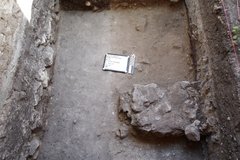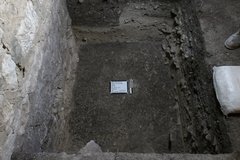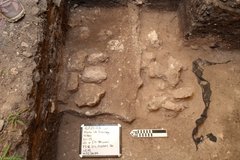Excavations continued at the Long Barrack this week, with four active units.
Archaeologists reached an approximate depth of 60 cm below surface in EU-8. A large electrical utility was removed from the unit. Archaeologists noted two different soil types within the unit, which corresponds to other units along the Long Barrack. The soil closest to the Long Barrack is the same builders’ trench seen in EUs 10 and 12. EU-8 differs from the other units this week with the density of cultural material, particularly ceramics.
A large sandy paste ceramic sherd was recovered from approximately 50 cm below surface. The rim sherd appears unglazed and displays distinct wheel-thrown striations with a coarse sandy paste. The sherd measures 11 mm thick and has an estimated rim diameter of approximately 13 cm. The size suggests the vessel was a type of jar, likely utilitarian in nature.







